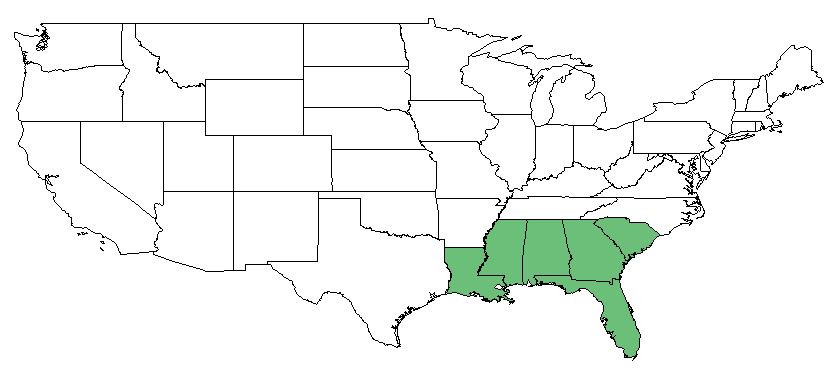Difference between revisions of "Collinsonia punctata"
(→Taxonomic Notes) |
(→Taxonomic Notes) |
||
| Line 22: | Line 22: | ||
Synonym: ''C. serotina'';<ref name="Weakley 2015"/><ref name="USDA"/> ''C. canadensis'' var. ''punctata''; ''Hypogon verticillata''; ''Micheliella anisata''<ref name="USDA"/> | Synonym: ''C. serotina'';<ref name="Weakley 2015"/><ref name="USDA"/> ''C. canadensis'' var. ''punctata''; ''Hypogon verticillata''; ''Micheliella anisata''<ref name="USDA"/> | ||
| − | The taxanomic identification of this species seems highly debated in the literature.<ref name="Peirson et al 2006"/> ''Collinsonia punctata'' is almost identical to ''[[Collinsonia anisata]]'' except for its different scent and the number of stamen (two).<ref name="Sims 1809"/><ref name="Ward 2014">Ward DB (2014) Thomas Walter typification project, VII: Observations on the genus ''Collinsonia'' (Labiatae) and a neotype for ''C. serotina'' Walter. Phytoneuron 89:1-5.</ref> In a 2006 manuscript, ''C. punctata'' is recognized as having two stamens instead of four and being an intermediate between ''C. canadensis'' and ''[[Collinsonia anisata]]''.<ref name="Peirson et al 2006">Peirson JA, Cantino PD, Ballard, Jr. HE (2006) A taxonomic revision of ''Collinsonia'' (Lamiaceae) based on phenetic analyses of morphological variation. Systematic Botany 31(2):398-409.</ref> | + | The taxanomic identification of this species seems highly debated in the literature.<ref name="Peirson et al 2006"/> ''Collinsonia punctata'' is almost identical to ''[[Collinsonia anisata]]'' except for its different scent and the number of stamen (two).<ref name="Sims 1809">Sims J (1809) ''Collinsonia anisata'' Curtis's Botanical Magazine 30:t.1213.</ref><ref name="Ward 2014">Ward DB (2014) Thomas Walter typification project, VII: Observations on the genus ''Collinsonia'' (Labiatae) and a neotype for ''C. serotina'' Walter. Phytoneuron 89:1-5.</ref> In a 2006 manuscript, ''C. punctata'' is recognized as having two stamens instead of four and being an intermediate between ''C. canadensis'' and ''[[Collinsonia anisata]]''.<ref name="Peirson et al 2006">Peirson JA, Cantino PD, Ballard, Jr. HE (2006) A taxonomic revision of ''Collinsonia'' (Lamiaceae) based on phenetic analyses of morphological variation. Systematic Botany 31(2):398-409.</ref> |
==Description== <!-- Basic life history facts such as annual/perrenial, monoecious/dioecious, root morphology, seed type, etc. --> | ==Description== <!-- Basic life history facts such as annual/perrenial, monoecious/dioecious, root morphology, seed type, etc. --> | ||
Revision as of 14:37, 15 February 2018
| Collinsonia punctata | |
|---|---|
Error creating thumbnail: Unable to save thumbnail to destination
| |
| Photo by from USDA NRCS Plants Database. | |
| Scientific classification | |
| Kingdom: | Plantae |
| Division: | Magnoliophyta - Flowering plants |
| Class: | Magnoliopsida - Dicots |
| Order: | Lamiales |
| Family: | Lamiaceae |
| Genus: | Collinsonia |
| Species: | C. punctata |
| Binomial name | |
| Collinsonia punctata Walter | |

| |
| Natural range of Collinsonia punctata[1] | |
Common Names: Florida horsebalm;[2] blue ridge horsebalm;[3]
Contents
Taxonomic Notes
Synonym: C. serotina;[2][3] C. canadensis var. punctata; Hypogon verticillata; Micheliella anisata[3]
The taxanomic identification of this species seems highly debated in the literature.[4] Collinsonia punctata is almost identical to Collinsonia anisata except for its different scent and the number of stamen (two).[5][6] In a 2006 manuscript, C. punctata is recognized as having two stamens instead of four and being an intermediate between C. canadensis and Collinsonia anisata.[4]
Description
Collinsonia serotina is a dioecious perennial forb/herb.[3]
Distribution
Ecology
Habitat
Use by animals
C. serotina composes 2-5% of the diet for some terrestrial birds.[7]
Conservation and Management
Cultivation and restoration
Photo Gallery
References and notes
- ↑ Weakley, Alan S. 2015. Flora of the Southern and Mid-Atlantic States: Working Draft of 21 May 2015. University of North Carolina, Chapel Hill, North Carolina. 1320 pp.
- ↑ 2.0 2.1 Weakley AS (2015) Flora of the Southern and Mid-Atlantic States. Chapel Hill, NC: University of North Carolina Herbarium.
- ↑ 3.0 3.1 3.2 3.3 USDA NRCS (2016) The PLANTS Database (http://plants.usda.gov, 15 February 2018). National Plant Data Team, Greensboro, NC 27401-4901 USA.
- ↑ 4.0 4.1 Peirson JA, Cantino PD, Ballard, Jr. HE (2006) A taxonomic revision of Collinsonia (Lamiaceae) based on phenetic analyses of morphological variation. Systematic Botany 31(2):398-409.
- ↑ Sims J (1809) Collinsonia anisata Curtis's Botanical Magazine 30:t.1213.
- ↑ Ward DB (2014) Thomas Walter typification project, VII: Observations on the genus Collinsonia (Labiatae) and a neotype for C. serotina Walter. Phytoneuron 89:1-5.
- ↑ Miller JH, Miller KV (1999) Forest plants of the southeast and their wildlife uses. Southern Weed Science Society.